2015-10-27
Abstract
For the first time since July 2014, all full solutions in this month's test achieved VBSpam certification. Moreover, an additional measure introduced this month showed that products rarely delayed the delivery of emails. Martijn Grooten reports.
Copyright © 2015 Virus Bulletin
A few weeks ago, a journalist contacted me to check whether an email sent to Hillary Clinton’s personal email account in 2011 could have been a Russian spear-phishing attempt that used a New York parking ticket as a lure, as had been reported by some media sources [1]. It was actually pretty clear that this was no targeted attack against Ms Clinton, but that her email address, like billions of others, had ended up on spammers’ lists. (Gary Warner has details of this particular campaign on his blog [2].)
While spear-phishing is a serious problem for many organizations, the fact that a target as prominent as the US Secretary of State received an email in a run-of-the-mill spam campaign shows that spam remains the background noise of the Internet. And though it is neither the most advanced nor the most exciting kind of cybercrime, its impact remains huge, both for systems administrators and for the millions of users who accidentally open email attachments every day.
Thankfully, as our VBSpam tests have regularly shown, there are many anti-spam solutions that help to mitigate the problem of spam at the network level. In this test, all 13 full solutions reached the required standard to earn a VBSpam award, and five of them achieved a VBSpam+ award.
Moreover, for the first time this month’s tests gave some insight into how long products took to filter emails.
The VBSpam test methodology can be found at http://www.virusbtn.com/vbspam/methodology/. As usual, emails were sent to the products in parallel and in real time, and products were given the option to block email pre-DATA (that is, based on the SMTP envelope and before the actual email was sent). However, on this occasion no products chose to make use of this option.
For those products running on our equipment, we use Dell PowerEdge machines. As different products have different hardware requirements – not to mention those running on their own hardware, or those running in the cloud – there is little point comparing the memory, processing power or hardware the products were provided with; we followed the developers’ requirements and note that the amount of email we receive is representative of that received by a small organization.
To compare the products, we calculate a ‘final score’, which is defined as the spam catch (SC) rate minus five times the weighted false positive (WFP) rate. The WFP rate is defined as the false positive rate of the ham and newsletter corpora taken together, with emails from the latter corpus having a weight of 0.2:
WFP rate = (#false positives + 0.2 * min(#newsletter false positives , 0.2 * #newsletters)) / (#ham + 0.2 * #newsletters)
Final score = SC - (5 x WFP)
As of this test, there are some additional criteria for the VBSpam award, based on the speed of delivery of emails in the ham corpus. To qualify for a VBSpam award, not only must the value of the final score be at least 98 but in addition, the speeds of delivery at 10 and 50 per cent must be classified as ‘green’ or ‘yellow’, and at 95 per cent they must be classified as ‘green’, ‘yellow’ or ‘orange’.
To earn a VBSpam+ award, products must combine a spam catch rate of 99.5% or higher with a lack of false positives and no more than 2.5% false positives among the newsletters – in addition, the speeds of delivery at 10 and 50 per cent must be classified as ‘green’, and at 95 and 98 per cent they must be classified as ‘green’ or ‘yellow’. The colour-coded speed classifications are explained later in this review.
The test started on Saturday 15 August at 12am and finished 16 days later, on Monday 31 August at 12am. There was a small problem which lasted a little over an hour in the early evening of 19 August (emails sent during this period were not included in the corpus), but it didn’t affect the rest of the test.
The test corpus consisted of 139,292 emails. 129,208 of these emails were spam, 64,790 of which were provided by Project Honey Pot, with the remaining 64,418 spam emails provided by spamfeed.me, a product from Abusix. They were all relayed to the products in real time, as were the 9,773 legitimate emails (‘ham’) and 311 newsletters.
Figure 1 shows the catch rate of all full solutions throughout the test. To avoid the average being skewed by poorly performing products, the highest and lowest catch rates have been excluded for each hour. We can see that the high catch rates that we observed in July continued in this test.
SMTP, which defines the delivery of email, is a store-and-forward protocol. Alice can send an email to Bob without Bob being online at that moment. Even when the email travels over the public Internet from Alice’s mail server to that of Bob, it’s not a problem if the latter is temporarily offline: a new delivery attempt is made a little while later.
Still, most people expect email to be delivered immediately. Indeed, a spam filter that decided to delay all emails by an hour – something which could allow it to respond better to new spam campaigns and thus improve its performance – would soon find itself losing customers.
In the VBSpam tests, we care about how email works and about how spam filters interfere in practice, not within the theoretical boundaries of SMTP. Hence we have always kept an eye on whether products artificially improve their performance by holding onto emails for a significant amount of time. While we have never had to ask products to change their behaviour, we thought it important to be open about by how long products delay the delivery of emails. As of this test, we will publish this data.
For this measure, we only look at the emails from the ham corpus. These are the emails that people expect to receive immediately (no one – other than the spammer – cares how long it takes to deliver a spam email, if it gets delivered at all). Moreover, some products use a variant of greylisting, in which the delivery of certain emails is delayed until some time has passed, hoping to be able to block the latest spam campaigns in this way. (Greylisting normally refers to a situation in which a 4xx ‘temporary error’ is sent to the sending mail server, under the often correct assumption that spammers haven’t set up their servers to re-attempt delivery. This kind of greylisting cannot be tested in the VBSpam set-up.) If the selection of emails to be delayed is done well, with few legitimate emails, this is a valid method that shouldn’t affect how users experience a product.
When looking at speed, we ignored false positives.
For each email from the ham corpus, we measured the time (in seconds) it took for a full email to be delivered back to us after our server had made a connection to the product. However, because a few seconds don’t make a noticeable difference (email isn’t suitable for situations where seconds can make a difference, including high-frequency trading) and there are many external factors (including the hardware on which the product runs) that influence the delivery time, we have decided not to publish the actual time it takes for products to deliver emails.
Instead, for each product we sort the emails by the time it took for them to be delivered back to us and then look at the emails at the 10, 50, 95 and 98 percentiles. For these emails, we use colour-coded categories to report the length of delay: 0–30 seconds (green); 30 seconds to two minutes (yellow); two minutes to 10 minutes (orange); and more than 10 minutes (red). For user experience, these values could be interpreted as near real-time delivery, a small delay, a significant delay, and a huge delay.
As mentioned earlier in the report, we also set some minimum values for this ‘speed’ in order for products to qualify for a VBSpam or VBSpam+ award. It was good to see that, based on their speed alone, all products qualified for a VBSpam award, and all but one would have qualified for a VBSpam+ award.
In the text that follows, unless otherwise specified, ‘ham’ or ‘legitimate email’ refers to email in the ham corpus – which excludes the newsletters – and a ‘false positive’ refers to a message in that corpus that has erroneously been marked by a product as spam.
SC rate: 99.76%
FP rate: 0.03%
Final score: 99.49
Project Honey Pot SC rate: 99.55%
Abusix SC rate: 99.98%
Newsletters FP rate: 3.9%
Speed: 10%:  ; 50%:
; 50%:  ; 95%:
; 95%:  ; 98%:
; 98%: 
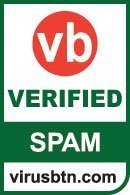
Axway’s MailGate virtual appliance was among the majority of products that returned at least 98% of emails within 30 seconds – which its customers and their users will no doubt appreciate. Customers will also be pleased with the catch rate of more than 99.75%, only marginally lower than that recorded in July, and just three false positives. With this performance, Axway achieves its tenth VBSpam award.
SC rate: 99.98%
FP rate: 0.00%
Final score: 99.98
Project Honey Pot SC rate: 99.98%
Abusix SC rate: 99.98%
Newsletters FP rate: 0.0%
Speed: 10%:  ; 50%:
; 50%:  ; 95%:
; 95%:  ; 98%:
; 98%: 
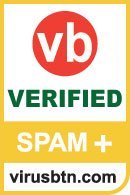
Bitdefender has achieved a VBSpam award in every one of the last 38 VBSpam tests, and this test proves that nothing funny is happening behind the scenes: at least 98 per cent of emails are returned within half a minute, thus creating a near real-time experience for the product’s users.
Even more importantly, and certainly more impressively, the product blocked 99.98% of spam – missing just 26 spam emails – and did so without a single false positive in either corpus of legitimate emails. Bitdefender’s 39th VBSpam award therefore comes with a big plus attached.
SC rate: 99.95%
FP rate: 0.02%
Final score: 99.84
Project Honey Pot SC rate: 99.91%
Abusix SC rate: 99.99%
Newsletters FP rate: 0.3%
Speed: 10%:  ; 50%:
; 50%:  ; 95%:
; 95%:  ; 98%:
; 98%: 

Egedian’s users may see a small percentage of email take slightly longer to arrive, but with 98 per cent arriving within a little over half a minute, that’s not going to have a major impact on user experience.
The main focus of these tests remains the products’ performance on the various corpora, and I was pleased to see the catch rate of Egedian Mail Security increase to 99.95%. This time, the product missed two legitimate emails, which were both from the same Russian sender, and thus the virtual solution came very close to winning its first VBSpam+ award. A regular VBSpam award was easily within its grasp though.
SC rate: 99.99%
FP rate: 0.01%
Final score: 99.93
Project Honey Pot SC rate: 99.98%
Abusix SC rate: 100.00%
Newsletters FP rate: 0.3%
Speed: 10%:  ; 50%:
; 50%:  ; 95%:
; 95%:  ; 98%:
; 98%: 

A move to a new (virtual) network means that we may soon have to replace Fortinet’s FortiMail appliance, which has been in our tests since July 2009 and which has never missed a VBSpam award, with a virtual version of the product. For now, this old appliance continues to perform very well – in fact, the spam catch rate of 99.99% (a mere 15 spam emails were missed) is FortiMail’s highest performance in 38 tests.
Unfortunately, there was a single false positive, which prevented the product from achieving a VBSpam+ award, but with the fifth highest final score, and an excellent speed too, Fortinet has many reasons to be pleased.
SC rate: 99.44%
FP rate: 0.01%
Final score: 99.38
Project Honey Pot SC rate: 99.48%
Abusix SC rate: 99.40%
Newsletters FP rate: 0.3%
Speed: 10%:  ; 50%:
; 50%:  ; 95%:
; 95%:  ; 98%:
; 98%: 

End-users whose emails are protected by GFI MailEssentials don’t have to wait long for their emails to arrive: the product filtered at least 98 per cent of emails in under 30 seconds.
This month, users would have seen a few more spam emails arrive in their inbox though, as the catch rate dropped to just below 99.5%. That is not a serious problem, and with low false positive rates, GFI easily earns another VBSpam award.
SC rate: 99.87%
FP rate: 0.00%
Final score: 99.87
Project Honey Pot SC rate: 99.77%
Abusix SC rate: 99.98%
Newsletters FP rate: 0.0%
Speed: 10%:  ; 50%:
; 50%:  ; 95%:
; 95%:  ; 98%:
; 98%: 

IBM’s Lotus Protector for Mail Security has performed well in the past year, earning three VBSpam+ awards. I am pleased that we are now able to show that this performance wasn’t achieved by holding onto the emails for an unreasonable amount of time: IBM’s ‘speed colours’ were all green.
In this test it also equalled the spam catch rate we recorded in the last test and combined this with a clean sheet in the ham and newsletter corpora. The product’s fourth VBSpam+ award is thus well deserved.
SC rate: 99.93%
FP rate: 0.02%
Final score: 99.83
Project Honey Pot SC rate: 99.89%
Abusix SC rate: 99.97%
Newsletters FP rate: 0.0%
Speed: 10%:  ; 50%:
; 50%:  ; 95%:
; 95%:  ; 98%:
; 98%: 

For Kaspersky Lab, the introduction of our speed ‘traffic lights’ did show that a minority of emails are returned with a noticeable delay. Whether this is something organizations will consider a problem depends on their particular needs. In this test, it would have prevented the company from achieving a VBSpam+ award – had two false positives not already done so.
However, another VBSpam award is still easily earned, especially considering the product’s high spam catch rate of 99.93%.
SC rate: 99.98%
FP rate: 0.00%
Final score: 99.98
Project Honey Pot SC rate: 99.96%
Abusix SC rate: 100.00%
Newsletters FP rate: 0.0%
Speed: 10%:  ; 50%:
; 50%:  ; 95%:
; 95%:  ; 98%:
; 98%: 

Libra Esva will no doubt be pleased that we can show that the product doesn’t hold onto emails to improve its performance: at least 98% of them were returned within 30 seconds. And when the emails did return, the product was almost always correct in its classification: only 24 spam emails were missed and no legitimate emails were misclassified. This resulted in a clean sheet, the highest final score of all products, and another VBSpam+ award for the product’s developers in Italy.
SC rate: 99.95%
FP rate: 0.01%
Final score: 99.84
Project Honey Pot SC rate: 99.90%
Abusix SC rate: 100.00%
Newsletters FP rate: 1.9%
Speed: 10%:  ; 50%:
; 50%:  ; 95%:
; 95%:  ; 98%:
; 98%: 

It was nice to see McAfee’s SaaS Email Protection return the emails very quickly, as using a hosted solution adds an extra hop over the public Internet which could delay delivery.
When it comes to classifying the emails correctly, McAfee performed very well too, blocking 99.95% of all spam emails, and with only one false positive – an email in Brazilian Portuguese – it was but a whisker away from earning a VBSpam+ award. Another VBSpam award for the industry giant is well deserved.
SC rate: 99.999%
FP rate: 0.00%
Final score: 99.98
Project Honey Pot SC rate: 99.999%
Abusix SC rate: 100.00%
Newsletters FP rate: 0.6%
Speed: 10%:  ; 50%:
; 50%:  ; 95%:
; 95%:  ; 98%:
; 98%: 

OnlyMyEmail’s performance has regularly stunned readers (and authors!) of the VBSpam reports and this was no exception: the product missed only one spam email in a corpus of almost 130,000 messages and erroneously blocked just two newsletters.
It was good to see that this impressive performance is not achieved by holding onto the emails for a long time – the fact that a small percentage of emails takes (just) over 30 seconds to be filtered is probably a natural consequence of the fact that this is a hosted solution, which requires an extra hop (and whose servers are on the other side of the ocean). With a very high final score, yet another VBSpam+ award goes to the product’s developers in Michigan.
SC rate: 99.41%
FP rate: 0.12%
Final score: 98.77
Project Honey Pot SC rate: 99.30%
Abusix SC rate: 99.52%
Newsletters FP rate: 1.0%
Speed: 10%:  ; 50%:
; 50%:  ; 95%:
; 95%:  ; 98%:
; 98%: 

Scrollout F1 had an unfortunate run earlier this year, failing to achieve a VBSpam award three times in a row. As mentioned in the last VBSpam report, we had come to suspect that the product might not have been fully adjusted to the test environment, and indeed that does seem to have been the case.
In this test, the product’s false positive rate dropped significantly: at 0.12% it remained higher than that of other products, but its final score was well above the VBSpam threshold. And thus, with four green speed markers, Scrollout ends its run of bad luck and earns another VBSpam award.
SC rate: 99.78%
FP rate: 0.02%
Final score: 99.67
Project Honey Pot SC rate: 99.70%
Abusix SC rate: 99.85%
Newsletters FP rate: 0.0%
Speed: 10%:  ; 50%:
; 50%:  ; 95%:
; 95%:  ; 98%:
; 98%: 

For Sophos’s Email Appliance, speed isn’t an issue: at least 98% of legitimate emails are returned well within half a minute, showing that the appliance – which has been running in our lab for almost six years – hasn’t ceased to perform well in all this time.
The same is true for the core metrics, where it blocked 99.78% of spam – roughly the same as in the last test. Due to two false positives, a VBSpam+ couldn’t be awarded, but with its 34th VBSpam award in succession, Sophos extends its unbroken run.
SC rate: 99.96%
FP rate: 0.00%
Final score: 99.95
Project Honey Pot SC rate: 99.93%
Abusix SC rate: 100.00%
Newsletters FP rate: 0.3%
Speed: 10%:  ; 50%:
; 50%:  ; 95%:
; 95%:  ; 98%:
; 98%: 

The yellow speed marker at the 98% mark means that SpamTitan returned a minority of emails with a delay of a little over 30 seconds. This isn’t something that many organizations would be likely to mind though, and with no false positives and an impressive 99.96% spam catch rate, the product earns its seventh VBSpam+ award.
SC rate: 41.51%
FP rate: 0.00%
Final score: 41.51
Project Honey Pot SC rate: 66.15%
Abusix SC rate: 16.74%
Newsletters FP rate: 0.0%
SC rate: 92.13%
FP rate: 0.00%
Final score: 92.13
Project Honey Pot SC rate: 86.42%
Abusix SC rate: 97.87%
Newsletters FP rate: 0.0%
SC rate: 95.17%
FP rate: 0.00%
Final score: 95.17
Project Honey Pot SC rate: 92.28%
Abusix SC rate: 98.08%
Newsletters FP rate: 0.0%
As the DNS protocol is designed to give a response almost instantly, it is very popular for blacklists like those of Spamhaus, for whom the added delay under normal circumstances like those in our test is negligible. Hence we don’t measure or report on the speed.
In this test, it was good to see the domain-based DBL improve its performance further – well over 40% of emails were blocked simply because they contained a blacklisted domain. This suggests that spammers aren’t as good at avoiding blacklisted domains as they have been recently.
The catch rate for Spamhaus’s IP-address based ZEN blacklist remains high at just over 92% of spam, thus showing how IP blacklists in general, and that of Spamhaus in particular, can help remove the bulk of the spam with no false positives (as in this test).
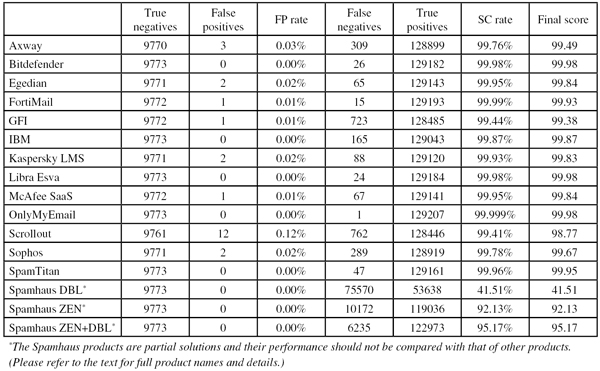
(Click here to view a larger version of the table.)
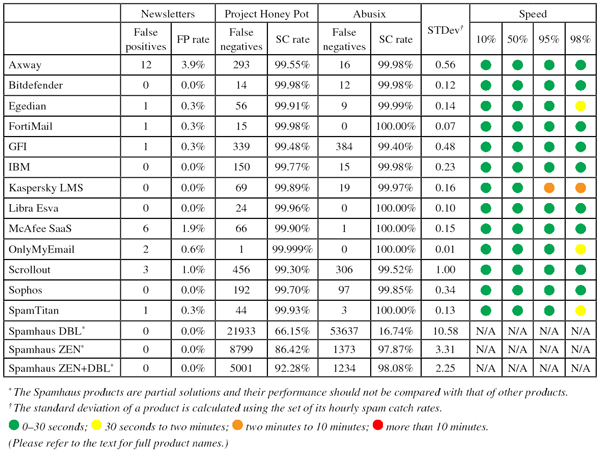
(Click here to view a larger version of the table.)
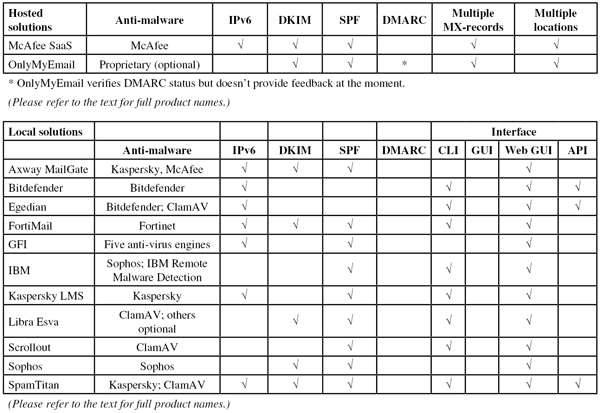
(Click here to view a larger version of the table.)
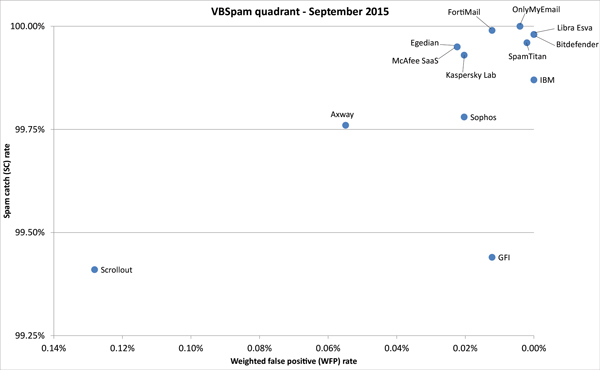
(Click here to view a larger version of the chart.)
Although, with 13 participating full solutions, this was the smallest VBSpam test in a long while, it was the first time since July 2014 that all full solutions achieved VBSpam certification. The good news was made all the better by the fact that products rarely delayed emails – or if they did, they managed to avoid doing so for legitimate emails.
The next VBSpam test will run in October–November 2015 (and is about to start at the time of writing this report), with the results scheduled for publication in November/December. Developers interested in submitting products should email [email protected].